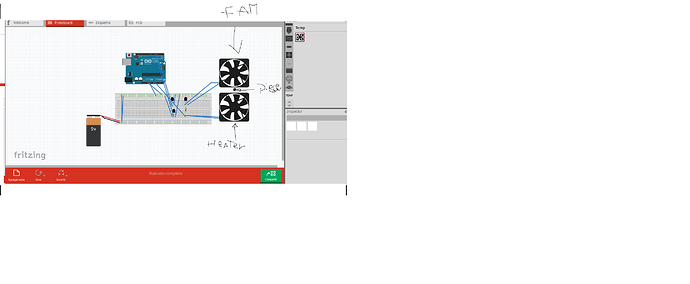hy, im trying to make the circuit of sistem that control the temperature of a piece with a fam and a heater in arduino Untitled Sketch 2.fzz (19.2 KB) ,
with a temperature sensor, example: when the information of the sensor is 40°C, i have to elevete the temperature to 50°C and when the sensor take 50°C i have to activate de fan to down the temperature, the problem is the code is ok, but i dont know how to make the circuit
Hello and welcome to the forum!
Could you please describe what you would be using this for? Would your ‘fan’ and ‘heater’ be using AC or DC? For AC loads, the is a ready made product that would probably fit your needs. If it’s DC loads, that would be different, but still easy to do.
Randy
The LM35 is an analog device, so “Vout” of each sensor needs to be connected to a different analog input pin. Be aware that you will not get the full resolution available from sensor itself this way. The Arduino has 10 bit analog to digital conversion, which is 1024 steps. So that full range of -55°C to 150°C is 195°, split into 1024 steps is about 0.19° per step. The sensor “reports” (as a voltage) a lot smaller changes than that, but the Arduino ADC can not tell the values apart.
The sketch file does not have any information on the fan. How is it to be controlled? For large (high power) fans, you might need a relay, or high power silicon switches. You will need at least a transistor (BJT or FET) to control them. An Arduino pin can not handle enough current to directly drive even the smallest fan motor.
Another consideration is the control method. Do you intend to just turn the fan on high until the temperature is low enough? Do you intend to control the speed of the motors to keep the temperature from changing as much and as fast.
Same things apply to the heater. How much current, how much voltage needs to be handled by the interface to the Arduino? Is that full on and full off only, or varying power levels. The minimal description provided makes this look like a good case to use PID control logic.
If you are already comfortable with the code, you might work through the temperature sensor, dc motor, and relay experiments from the Arduino Experimenters Kit. The TMP36 used there works very much like the LM35. The other 2 show ways of controlling larger loads from the Arduino.
For this circuit i dont need to control the velocity of the fan, this is a project of my university and is just simulate the circuit, without consider the voltage, i just need to make the conections, not much complicated but my proffesor give me 1 day to make this and i never used fritzing before
Have you done electronics before? That is schematic diagrams. Do you know what a transistor is, and how to use it as a switch? For that level, the limited resolution of the Arduino ADC is not going to matter. See the schematics (and breadboard view) for the experiments I referenced. They have fritzing diagrams for each. That should have everything need to physically connect the pieces. For the purpose of interfacing, the heater can be treated exactly the same as the motor. It is just a load that needs to be turned on and off. It may not need the flyback diode, but it won’t hurt to include it.
no, i never done electronics, my professor is crazy  i know how it works the transistor but my principal problem is how to conect the fams to the rele and to the sensor, i need to do this in the most simple way.
i know how it works the transistor but my principal problem is how to conect the fams to the rele and to the sensor, i need to do this in the most simple way.
btw thanks for your time broder, you are amazing
hey, its going to be for AC, do you have this “product”? it would be amazing if you can send me, my time is running out
@mizent - This to me is an unreal expectation and you should just submit what you have. I looked at your file and I have to say, with your limited electronics experience, you actually had a good start. You had some parts in your file that were right, and some that kinda looked right, but weren’t right, because you don’t know electronics.
Just turn in what work you have, you are actually about 1/3 of the way to having a basic design. I don’t think anything more than you have done could be expected from someone with limited electronic experience.
Good luck!
Randy
